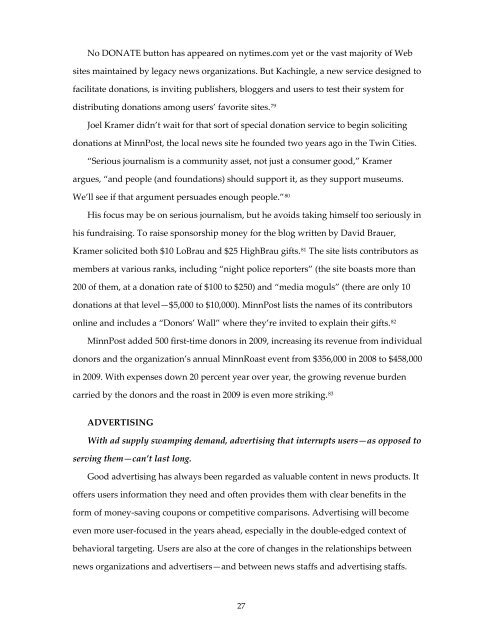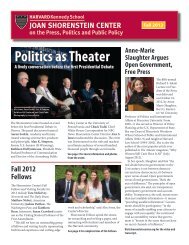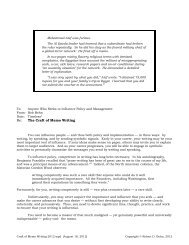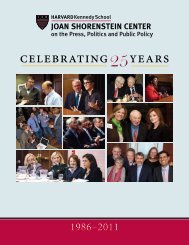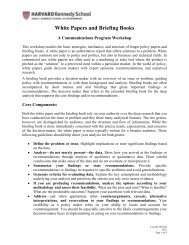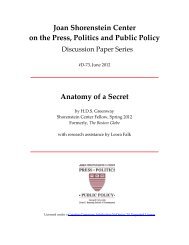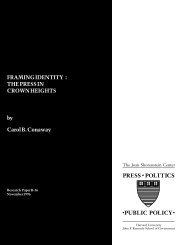A User-First Framework for Sustaining Local News - Harvard ...
A User-First Framework for Sustaining Local News - Harvard ...
A User-First Framework for Sustaining Local News - Harvard ...
You also want an ePaper? Increase the reach of your titles
YUMPU automatically turns print PDFs into web optimized ePapers that Google loves.
No DONATE button has appeared on nytimes.com yet or the vast majority of Web<br />
sites maintained by legacy news organizations. But Kachingle, a new service designed to<br />
facilitate donations, is inviting publishers, bloggers and users to test their system <strong>for</strong><br />
distributing donations among users’ favorite sites. 79<br />
Joel Kramer didn’t wait <strong>for</strong> that sort of special donation service to begin soliciting<br />
donations at MinnPost, the local news site he founded two years ago in the Twin Cities.<br />
“Serious journalism is a community asset, not just a consumer good,” Kramer<br />
argues, “and people (and foundations) should support it, as they support museums.<br />
We’ll see if that argument persuades enough people.” 80<br />
His focus may be on serious journalism, but he avoids taking himself too seriously in<br />
his fundraising. To raise sponsorship money <strong>for</strong> the blog written by David Brauer,<br />
Kramer solicited both $10 LoBrau and $25 HighBrau gifts. 81 The site lists contributors as<br />
members at various ranks, including “night police reporters” (the site boasts more than<br />
200 of them, at a donation rate of $100 to $250) and “media moguls” (there are only 10<br />
donations at that level—$5,000 to $10,000). MinnPost lists the names of its contributors<br />
online and includes a “Donors’ Wall” where they’re invited to explain their gifts. 82<br />
MinnPost added 500 first‐time donors in 2009, increasing its revenue from individual<br />
donors and the organization’s annual MinnRoast event from $356,000 in 2008 to $458,000<br />
in 2009. With expenses down 20 percent year over year, the growing revenue burden<br />
carried by the donors and the roast in 2009 is even more striking. 83<br />
ADVERTISING<br />
With ad supply swamping demand, advertising that interrupts users—as opposed to<br />
serving them—can’t last long.<br />
Good advertising has always been regarded as valuable content in news products. It<br />
offers users in<strong>for</strong>mation they need and often provides them with clear benefits in the<br />
<strong>for</strong>m of money‐saving coupons or competitive comparisons. Advertising will become<br />
even more user‐focused in the years ahead, especially in the double‐edged context of<br />
behavioral targeting. <strong>User</strong>s are also at the core of changes in the relationships between<br />
news organizations and advertisers—and between news staffs and advertising staffs.<br />
27


